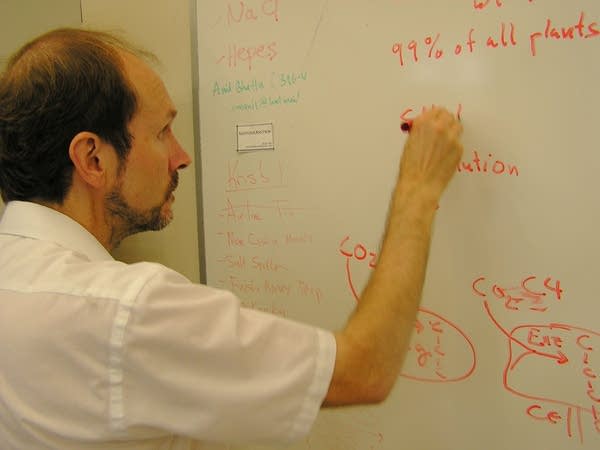Turbocharged plants
Go Deeper.
Create an account or log in to save stories.
Like this?
Thanks for liking this story! We have added it to a list of your favorite stories.

The wind sighs through the tallgrass prairie as bright sunshine beats down on the native landscape near Moorhead.
Switchgrass is one of the native prairie plants growing here. It's been getting a lot of attention as a potential source for cellulosic ethanol.

It turns out that in the plant world, switchgrass has a distinct advantage. It's one of a few plants that have evolved a sort of turbocharged photosynthesis, called C4 by biologists.
"It's C4 country right here," says Chris Chastain. "Where the corn belt is, that's where the tallgrass prairie was, that's C4 country. Corn is also C4."
Turn Up Your Support
MPR News helps you turn down the noise and build shared understanding. Turn up your support for this public resource and keep trusted journalism accessible to all.
There's no switchgrass in Chris Chastain's lab at Minnesota State University in Moorhead. But there's an enzyme growing in a petri dish that might be a key to regulating plant growth.
Plants take in sunlight and absorb carbon dioxide from the air, and produce sugar that fuels plant growth. That's photosynthesis. Think of it as an engine. Fuel in, power out.
"We found something nobody's seen before. We matched it against all other known genes that have been cloned. There's nothing like it."
Most plants are what biologists call C3 -- the photosynthesis process is either on or it's off. The sun comes up. The engine starts. The sun goes down. The engine stops.
In the 1980s, scientists found some plants are different. They're called C4, and it's like their engine is turbocharged, and has an accelerator -- the speed of photosynthesis adjusts according to light levels.
"Light comes up. Says wake up, go to work. Dark cloud comes over -- slow down. Dark cloud passes -- OK, speed up again," explains Chris Chastain.
That makes the plant much more efficient, because the engine puts out more power.
Scientists think C4 plants evolved some 20 million years ago as a way to survive environmental changes.
Scientists believe they recently discovered some plants in the midst of evolving from C3 to C4. But they're still trying to understand how the process works.
That's where Chris Chastain's discovery comes in. He calls it finding a unicorn.

"We found something nobody's seen before. We matched it against all other known genes that have been cloned. There's nothing like it," says Chastain.
The gene tells the plant to create certain enzymes, which appear to act as the accelerator on the plant engine.
C4 plants store carbon dioxide in tiny pressurized chambers in the leaves. When there's bright sunlight, the enzyme feeds that pressurized CO2 into the engine, producing more sugar, which fuels more aggressive plant growth.
Chris Chastain says C4 plants can put out twice as much energy as other plants.
"Now we can think of -- why can't we use this great productivity to make not just grain, but biomass, leaf material, cellulose," says Chastain.
Cellulose is the focus of new efforts in ethanol products. Grasses, like switchgrass, would be used instead of crops like corn to make ethanol.

Chastain is working with researchers at Cambridge University in England to understand the mechanics of the enzyme. He wants to know how it controls the speed of photosynthesis.
Will it allow scientists to manipulate how fast plants grow, and how big they get, by making most efficient use of sunlight?
"That's been the holy grail since they discovered this process," says Chastain. "We want to make C4 plants out of C3 crops. It's not been until the recent few years we've had the tools to say, we've got a sporting chance to do it."
Other researchers are already experimenting with genetic manipulation to create a C4 rice plant. Such a plant could potentially produce twice as much rice.
Chris Chastain says he won't be creating any new super plants. He's spent his career focused on the enzyme in the petri dish, and there's still much to be learned about his discovery. He's excited about the potential, but unwilling to make predictions.
"You know what Einstein said when somebody asked him what good his relativity was. He replied, 'What good is a newborn baby?' That's pretty wise. It's just a baby, but it could grow up to be president, or some great doctor, or who knows," says Chastain.
Chastain is sharing copies of his cloned enzyme with other researchers who want to see if it's a missing piece they need to complete the genetic puzzle and grow turbocharged plants.



